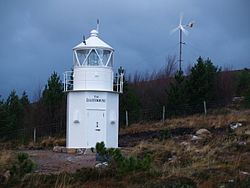Scoraig
| Scoraig Gaelic: Sgoraig | |
| Cromartyshire | |
|---|---|
 The old lighthouse at Scoraig | |
| Location | |
| Grid reference: | NH005965 |
| Location: | 57°54’47"N, 5°22’10"W |
| Data | |
| Postcode: | IV23 |
| Local Government | |
| Council: | Highland |
Scoraig is a hamlet located on a remote peninsula between Little Loch Broom and Loch Broom, south of Ullapool in Cromartyshire.
Today it is known for its remoteness (reachable only by boat or about five miles' walk),[1] its somewhat "alternative" atmosphere, organic food production, and its pioneering use of wind power. It offers a retreat centre, remedial herbs and some basic self-catering accommodation. Its reputation may have been undermined in recent years due to increased usage of powered transport (such as all-terrain vehicle and backup generators to support higher energy demanding lives in which large televisions and freezer units are used regardless of wind power input. However, by far the biggest source of the electricity used on Scoraig in 2009 is still the wind (using ever more and larger turbines) and some supplementary solar PV arrays. It is quite close to Gruinard Island.
Scoraig has experienced several waves of human habitation. A ruin (considered by some to be a monastery) on the north shore of the peninsula at Annat is thought to date from the 1st millennium. The land was divided up in the 19th century into crofts with narrow holdings of agricultural land to support subsistence famring, towards the end of which the populations peaked at several hundred.
At one time Scoraig supported a relatively wealthy merchant by the name of MacIver, whose shop received goods by steamship from Glasgow and distributed them not only to other 'Scorreachean' (natives of Scoraig) but also to the wider Inner Hebrides area.
Scoraig's remote location, its increasing marginalisation from the wider area as road and rail networks gained in prominence at the expense of the steamer, and two World Wars, severely diminished its population and by 1960 it was almost deserted. The last permanent residents left in 1964.
Another wave of settlement from that time on, consisting mainly of 'good-lifers', 'back-to-the-landers', hippies etc. began in the 1960s and persists to this time. There are today several 'third-generation' children, whose parents were born in Scoraig.
Many of the jobs on Scoraig are connected with local services such as the school, the postal deliveries, 'community enhancement' projects etc., but many residents support themselves through traditional activities such as crofting, stonewalling and trawling, as well as violin-making, vegetable-growing, building trades and wind-power training courses.
Second generation resident Tommy Beavitt asserts that "the internal economic mainstay of the 'community' is the capital brought in by newcomers, which is generally spent on building 'properties', largely outside normal planning regulations."
There is a school, which provides primary education to approximately 12 children. Most children over the age of 14 go to Ullapool school, to which they either commute weekly or their parent(s) move house at this point in order to provide them with a secondary education. Scoraig is also known for the growth of plots of remedial herbs, and a tree nursery.
The old lighthouse at Scoraig is a sight of the village. It was moved to this site and converted to a museum. Behind it stands a locally designed wind turbine.
Outside links
| ("Wikimedia Commons" has material about Scoraig) |
- Community website
- Scoraig Wind - Hugh Piggott's page about small wind turbines
- 'The remote UK community living off-grid': BBC News In Pictures, 19 November 2018
References
- ↑ "Pupil ferries in the Highlands to go out to tender". BBC News Scotland online. 6 December 2011. http://www.bbc.co.uk/news/uk-scotland-highlands-islands-16031947. Retrieved 6 December 2011.